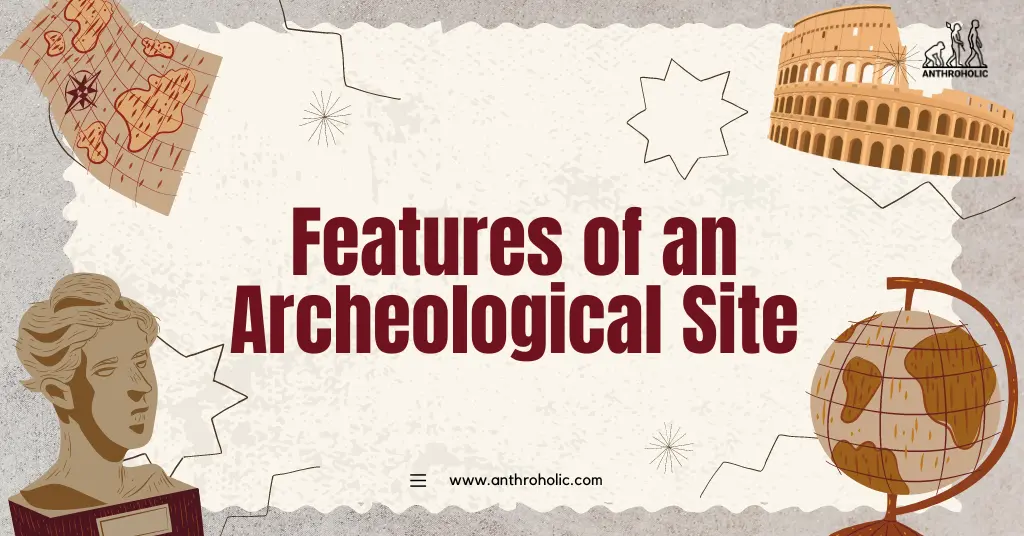AI Answer Evaluation Platform Live Now. Try Free Answer Evaluation Now
Features of an Archaeological Site
An archaeological site is a place where past human activity is identified, often by the discovery of artifacts, ecofacts, or architectural remains [1]. These sites hold an abundant source of information about the societies that once existed and their activities.

Built Structures
- Cairn: A cairn is a man-made pile or stack of stones, often used to mark burial sites, paths or boundaries. They are prevalent globally and date back to prehistoric times. Cairns can range from small rock piles to large mounds.
- Megalithic Tomb: Megalithic tombs are large stone structures that served as burial sites in Neolithic and Bronze Age societies. They are categorized into types like dolmens, passage tombs, or court cairns. Megalithic tombs often indicate complex societies with rituals around death and the afterlife.
- Pyramid: Pyramids are monumental structures with a square or triangular base and sloping sides that meet at a point at the top. The most famous pyramids were built in Egypt as tombs for Pharaohs. Pyramids provide insights into the architectural, religious, and social aspects of the societies that built them.
- Sepulchre and Tomb: Sepulchres and tombs are structures or places of interment. They can range from simple burial pits to elaborate monuments, revealing information about burial practices, beliefs about death and the afterlife, and social hierarchies.
Ritual Sites
Votive Site
Votive sites are places where objects (votive offerings) are left as a part of religious ritual. These offerings were typically made in dedication to a deity or in hope of a favor or miracle. Discovering such a site can offer extensive details about the religious practices and beliefs of a society.
Material Remains
- Assemblage: An assemblage refers to a group of artifacts recovered from a site, region, or time period, which are analyzed together. Studying an assemblage allows archaeologists to make interpretations about past human behavior and cultural practices.
- Grave Goods: Grave goods are objects that are buried with a corpse, often to assist the deceased in the afterlife. They can range from everyday items to valuable objects. They offer insight into the beliefs, values, and social structures of the societies they come from.
- Hoard: A hoard refers to a collection of valuable objects or artifacts, often buried or hidden. The study of hoards can reveal economic systems, trade connections, and societal instability or threats.
- Manuport: A manuport is a natural object which has been moved from its original context by human agency but has not been further modified. Manuports provide insight into early human behavior and cognition.
- Sarcophagus: A sarcophagus is a stone coffin, often adorned with sculptures or inscriptions. Typically used for the burial of the elite or royals, sarcophagi provide valuable information on the deceased individuals, their societies, and burial practices.
- Small Finds: Small finds are individual artifacts discovered at a site that can be easily moved. They can range from tools to jewelry and offer a rich source of information on the daily life, technology, and art of a society.
- Stone Tools: Stone tools, made by chipping or grinding, provide evidence of technological development and human behavior. They reveal information about hunting, food preparation, and other activities.
- Votive Deposit: Votive deposits are objects left at sacred sites as offerings. These can include everyday objects, special items, or animal/human remains, giving insights into religious practices and beliefs.
Geometric and Astronomical Features
Alignment
Alignment in archaeological terms refers to the intentional orientation of structures or features in relation to astronomical phenomena or landscape features. This can give us insight into a culture’s knowledge of astronomy and its significance in their society.
| Features of Archaeological Sites | Importance |
|---|---|
| Built Structures (Cairn, Tomb, Pyramid) | Insights into architectural abilities, social structures, and rituals |
| Ritual Sites (Votive Sites) | Understanding of religious beliefs and practices |
| Material Remains (Grave Goods, Hoards, Stone Tools) | Knowledge about daily life, economy, and technological advancements |
| Geometric and Astronomical Features (Alignment) | Indications of astronomical knowledge and its societal relevance |
Importance of Archaeological Site Features
Understanding the features of archaeological sites is critical for several reasons:
- Historical Understanding: Analyzing these elements helps to reconstruct past societies, their daily activities, belief systems, social organization, and technological capabilities [2].
- Cultural Heritage: These sites represent a tangible link to our past, and their preservation and study are key to maintaining a cultural legacy [3].
- Education and Tourism: Archaeological sites serve as important educational resources, offering hands-on learning experiences. They also draw tourism, promoting local economies.
Preservation and Protection
Maintaining the integrity of archaeological sites and their features is a significant concern. It involves:
- Preventing looting and illegal artifact trafficking.
- Minimizing damage from natural disasters and human activities.
- Implementing laws and policies to protect archaeological resources.
Technological Advances in Archaeology
Advances in technology have vastly improved our ability to analyze archaeological sites and their features. For example:
- Geographical Information Systems (GIS): Helps in mapping and analyzing sites and features spatially.
- Radiocarbon Dating: Allows for precise dating of organic materials.
- Remote Sensing and LiDAR: Enables the discovery of new sites and features, and mapping of landscapes.
- DNA Analysis: Provides information on human migration, diet, disease, and kinship.
| Technological Advances in Archaeology | Application |
|---|---|
| Geographical Information Systems (GIS) | Mapping and spatial analysis |
| Radiocarbon Dating | Dating of organic materials |
| Remote Sensing and LiDAR | Discovery and mapping of sites |
| DNA Analysis | Understanding of human migration, diet, disease, and kinship |
Conclusion
The variety of features found at archaeological sites offers a window into the past, providing valuable information about human history. Technological advancements are continually improving our ability to investigate and interpret these features, deepening our understanding of human culture and development.
References
[1] Renfrew, C., & Bahn, P. (2012). Archaeology: Theories, methods, and practice. Thames & Hudson.
[2] Hodder, I. (1999). The Archaeological Process: An Introduction. Blackwell Publishers.
[3] Cleere, H. (1989). Archaeological Heritage Management in the Modern World. Routledge.




